建筑ArchitecturePresentation
中国传统建筑英语presentation

中国传统建筑英语presentationChina's traditional architecture, also known as Chinese architecture, is a rich and diverse architectural style that has evolved over thousands of years. It reflects the country's cultural heritage and has had a profound influence on architectural styles in East Asia.One of the most iconic features of Chinese traditional architecture is the emphasis on harmony with nature. The design principles are based on the concept of Feng Shui, which seeks to create a balanced and harmonious environment. Buildings are often situated in harmony with the natural landscape, and the use of natural materials, such as wood and stone, is prioritized.Another key characteristic of Chinese traditional architecture is its use of symbolism. Buildings are often designed with auspicious symbols and motifs to bring good luck and fortune. For example, the color red, which represents happiness and vitality, is commonly used in traditional Chinese buildings.Chinese traditional architecture is also known for its intricate and detailed ornamentation. Elaborate carvings, ornate roofs, and colorful paintings are commonly seen in traditional Chinese buildings. These decorative elements not only add beauty to the structures but also showcase the craftsmanship and artistic skills of the craftsmen.The most well-known type of Chinese traditional architecture is the courtyard house, or Siheyuan. This type of building features a central courtyard surrounded by buildings on all four sides. The courtyard serves as a communal space for social interactions and isalso designed to provide sufficient ventilation and natural light to the surrounding rooms.Another iconic architectural style in China is the pagoda, which is a tall and multi-tiered tower. Pagodas are often found in Buddhist temples and are regarded as sacred structures. They were originally built to house relics and scriptures and serve as a place for meditation and religious rituals.Despite the influence of Western architectural styles in modern China, traditional Chinese architecture continues to be preserved and celebrated. Many historical buildings and ancient towns have been listed as UNESCO World Heritage sites, such as the Forbidden City in Beijing and the Confucius Temple in Qufu.In conclusion, Chinese traditional architecture is a unique and significant part of the country's cultural heritage. Its emphasis on harmony with nature, symbolism, and intricate ornamentation reflects the deep-rooted values and beliefs of the Chinese people. It is not only a testament to the craftsmanship and skill of the architects but also a visual representation of China's rich cultural history.。
关于建筑的主讲英文稿范文
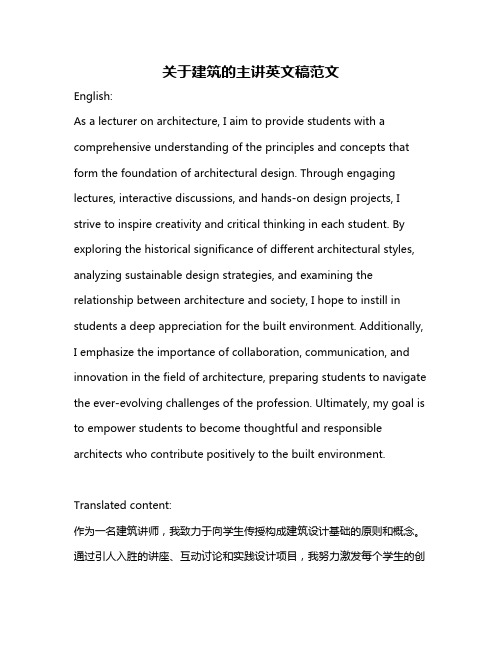
关于建筑的主讲英文稿范文English:As a lecturer on architecture, I aim to provide students with a comprehensive understanding of the principles and concepts that form the foundation of architectural design. Through engaging lectures, interactive discussions, and hands-on design projects, I strive to inspire creativity and critical thinking in each student. By exploring the historical significance of different architectural styles, analyzing sustainable design strategies, and examining the relationship between architecture and society, I hope to instill in students a deep appreciation for the built environment. Additionally, I emphasize the importance of collaboration, communication, and innovation in the field of architecture, preparing students to navigate the ever-evolving challenges of the profession. Ultimately, my goal is to empower students to become thoughtful and responsible architects who contribute positively to the built environment.Translated content:作为一名建筑讲师,我致力于向学生传授构成建筑设计基础的原则和概念。
建筑类英语演讲稿范文高中
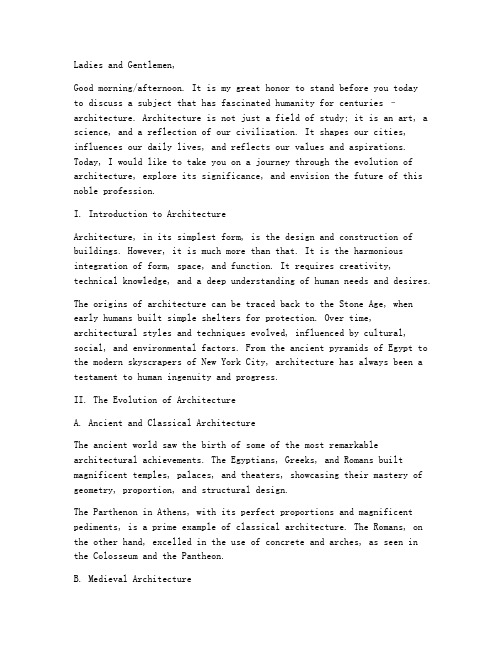
Ladies and Gentlemen,Good morning/afternoon. It is my great honor to stand before you today to discuss a subject that has fascinated humanity for centuries –architecture. Architecture is not just a field of study; it is an art, a science, and a reflection of our civilization. It shapes our cities, influences our daily lives, and reflects our values and aspirations. Today, I would like to take you on a journey through the evolution of architecture, explore its significance, and envision the future of this noble profession.I. Introduction to ArchitectureArchitecture, in its simplest form, is the design and construction of buildings. However, it is much more than that. It is the harmonious integration of form, space, and function. It requires creativity, technical knowledge, and a deep understanding of human needs and desires.The origins of architecture can be traced back to the Stone Age, when early humans built simple shelters for protection. Over time, architectural styles and techniques evolved, influenced by cultural, social, and environmental factors. From the ancient pyramids of Egypt to the modern skyscrapers of New York City, architecture has always been a testament to human ingenuity and progress.II. The Evolution of ArchitectureA. Ancient and Classical ArchitectureThe ancient world saw the birth of some of the most remarkable architectural achievements. The Egyptians, Greeks, and Romans built magnificent temples, palaces, and theaters, showcasing their mastery of geometry, proportion, and structural design.The Parthenon in Athens, with its perfect proportions and magnificent pediments, is a prime example of classical architecture. The Romans, on the other hand, excelled in the use of concrete and arches, as seen in the Colosseum and the Pantheon.B. Medieval ArchitectureMedieval architecture was characterized by the use of stone and wood in the construction of churches, castles, and cathedrals. The Gothic style, with its pointed arches, ribbed vaults, and flying buttresses, allowedfor the construction of ever-taller buildings.The Notre-Dame de Paris and the Chartres Cathedral are some of the most famous examples of Gothic architecture. These structures were not only places of worship but also symbols of the power and wealth of the Catholic Church.C. Renaissance and Baroque ArchitectureThe Renaissance brought about a renewed interest in classical art and architecture. Artists and architects like Leonardo da Vinci and Michelangelo studied the works of the ancients and sought to incorporate their principles into their own designs.Baroque architecture, which followed the Renaissance, was characterized by its elaborate ornamentation, dramatic use of light and shadow, and grandiose scale. The Palace of Versailles and St. Peter's Basilica in Rome are iconic examples of Baroque architecture.D. Modern and Contemporary ArchitectureModern architecture emerged in the late 19th century, marked by a break from traditional styles and an emphasis on simplicity, functionality,and the use of new materials. Architects like Le Corbusier and Frank Lloyd Wright revolutionized the field with their innovative designs.Contemporary architecture, which continues to evolve today, is characterized by a wide range of styles and techniques. It encompasses everything from minimalist designs to avant-garde structures that push the boundaries of what is possible.III. The Significance of ArchitectureA. Social and Cultural ImpactArchitecture plays a crucial role in shaping our social and cultural landscape. It reflects the values, beliefs, and aspirations of a society.Buildings like the Eiffel Tower and the Statue of Liberty have become symbols of national pride and unity.B. Environmental ImpactArchitecture has a significant impact on the environment. Sustainable design principles aim to minimize the ecological footprint of buildings, reduce energy consumption, and create healthier living spaces. Green roofs, solar panels, and passive design are just a few examples of sustainable architectural practices.C. Economic ImpactThe construction industry is one of the largest contributors to the global economy. Architecture not only creates jobs but also stimulates economic growth through the development of new buildings and infrastructure.IV. The Future of ArchitectureThe future of architecture is exciting and challenging. As technology advances, we will see new materials, techniques, and design tools emerge. Some of the key trends in the future of architecture include:A. Smart BuildingsSmart buildings will use advanced technology to optimize energy consumption, improve comfort, and enhance security. These buildings will be capable of adapting to changing needs and conditions, providing a seamless and efficient living experience.B. Modular ConstructionModular construction involves the assembly of prefabricated componentsto create buildings. This method is faster, more cost-effective, and sustainable, as it reduces waste and energy consumption.C. BiotechnologyBiotechnology will enable architects to design buildings that are not only functional but also capable of interacting with their environment.Buildings may even incorporate living organisms to perform tasks such as filtering air and water.D. Virtual Reality and Augmented RealityVirtual reality and augmented reality will revolutionize the way architects design and collaborate. These technologies will allow for immersive design experiences, enabling architects to visualize and manipulate their designs in real-time.Ladies and Gentlemen,Architecture is a journey that has spanned thousands of years and will continue to evolve in the future. As we move forward, it is essential that we remain committed to innovation, sustainability, and the creation of spaces that enhance the human experience.Thank you for joining me on this journey through the art and science of architecture. Let us continue to explore, create, and build a futurethat is both beautiful and sustainable.[Applause]。
英语介绍建筑演讲稿
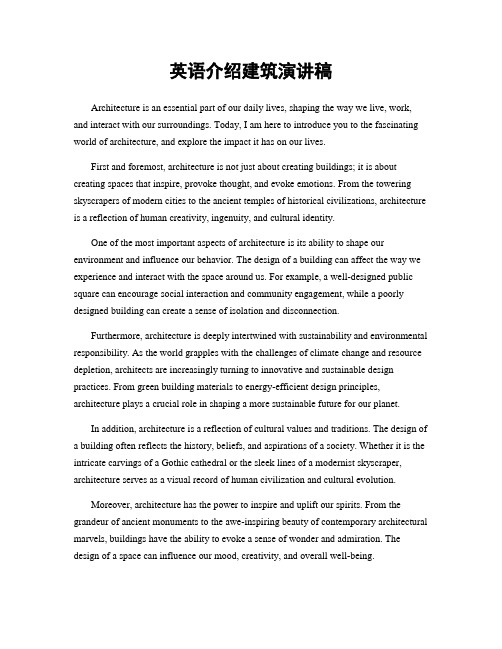
英语介绍建筑演讲稿Architecture is an essential part of our daily lives, shaping the way we live, work, and interact with our surroundings. Today, I am here to introduce you to the fascinating world of architecture, and explore the impact it has on our lives.First and foremost, architecture is not just about creating buildings; it is about creating spaces that inspire, provoke thought, and evoke emotions. From the towering skyscrapers of modern cities to the ancient temples of historical civilizations, architecture is a reflection of human creativity, ingenuity, and cultural identity.One of the most important aspects of architecture is its ability to shape our environment and influence our behavior. The design of a building can affect the way we experience and interact with the space around us. For example, a well-designed public square can encourage social interaction and community engagement, while a poorly designed building can create a sense of isolation and disconnection.Furthermore, architecture is deeply intertwined with sustainability and environmental responsibility. As the world grapples with the challenges of climate change and resource depletion, architects are increasingly turning to innovative and sustainable design practices. From green building materials to energy-efficient design principles, architecture plays a crucial role in shaping a more sustainable future for our planet.In addition, architecture is a reflection of cultural values and traditions. The design of a building often reflects the history, beliefs, and aspirations of a society. Whether it is the intricate carvings of a Gothic cathedral or the sleek lines of a modernist skyscraper, architecture serves as a visual record of human civilization and cultural evolution.Moreover, architecture has the power to inspire and uplift our spirits. From the grandeur of ancient monuments to the awe-inspiring beauty of contemporary architectural marvels, buildings have the ability to evoke a sense of wonder and admiration. The design of a space can influence our mood, creativity, and overall well-being.In conclusion, architecture is a multifaceted discipline that encompasses art, science, and social responsibility. It shapes our environment, influences our behavior, and reflects our cultural identity. As we continue to navigate the complexities of the modern world, the role of architecture in shaping our lives and communities will only become more significant. Let us embrace the power of architecture to create a more sustainable, inspiring, and harmonious world for generations to come. Thank you.。
介绍建筑英语演讲稿
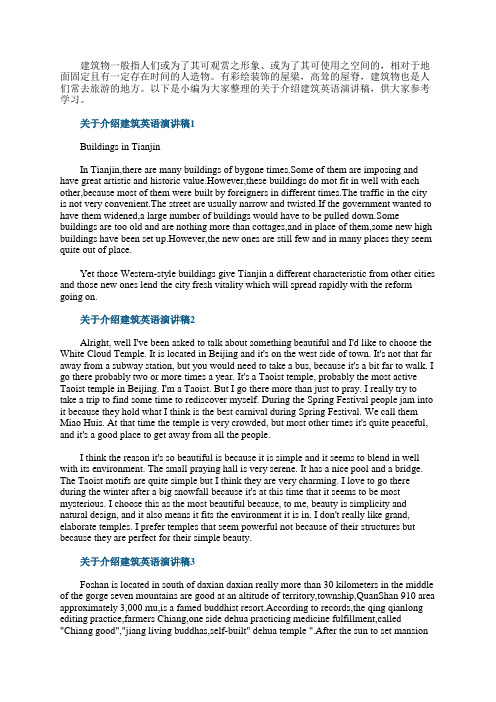
建筑物一般指人们或为了其可观赏之形象、或为了其可使用之空间的,相对于地面固定且有一定存在时间的人造物。
有彩绘装饰的屋梁,高耸的屋脊,建筑物也是人们常去旅游的地方。
以下是小编为大家整理的关于介绍建筑英语演讲稿,供大家参考学习。
关于介绍建筑英语演讲稿1Buildings in TianjinIn Tianjin,there are many buildings of bygone times.Some of them are imposing and have great artistic and historic value.However,these buildings do mot fit in well with each other,because most of them were built by foreigners in different times.The traffic in the city is not very convenient.The street are usually narrow and twisted.If the government wanted to have them widened,a large number of buildings would have to be pulled down.Some buildings are too old and are nothing more than cottages,and in place of them,some new high buildings have been set up.However,the new ones are still few and in many places they seem quite out of place.Yet those Western-style buildings give Tianjin a different characteristic from other cities and those new ones lend the city fresh vitality which will spread rapidly with the reform going on.关于介绍建筑英语演讲稿2Alright, well I've been asked to talk about something beautiful and I'd like to choose the White Cloud Temple. It is located in Beijing and it's on the west side of town. It's not that far away from a subway station, but you would need to take a bus, because it's a bit far to walk. I go there probably two or more times a year. It's a Taoist temple, probably the most active Taoist temple in Beijing. I'm a Taoist. But I go there more than just to pray. I really try to take a trip to find some time to rediscover myself. During the Spring Festival people jam into it because they hold what I think is the best carnival during Spring Festival. We call them Miao Huis. At that time the temple is very crowded, but most other times it's quite peaceful, and it's a good place to get away from all the people.I think the reason it's so beautiful is because it is simple and it seems to blend in well with its environment. The small praying hall is very serene. It has a nice pool and a bridge. The Taoist motifs are quite simple but I think they are very charming. I love to go there during the winter after a big snowfall because it's at this time that it seems to be most mysterious. I choose this as the most beautiful because, to me, beauty is simplicity and natural design, and it also means it fits the environment it is in. I don't really like grand, elaborate temples. I prefer temples that seem powerful not because of their structures but because they are perfect for their simple beauty.关于介绍建筑英语演讲稿3Foshan is located in south of daxian daxian really more than 30 kilometers in the middle of the gorge seven mountains are good at an altitude of territory,township,QuanShan 910 area approximately 3,000 mu,is a famed buddhist resort.According to records,the qing qianlong editing practice,farmers Chiang,one side dehua practicing medicine fulfillment,called "Chiang good","jiang living buddhas,self-built" dehua temple ".After the sun to set mansionmagistrate was to ask the rightful heir,convinced that he is "spirit" and ordered a true buddhist temple,and book of expansion "foshan" engraved on temple gate,which name.True foshan,from the bottom of the hill to the steep,conifers,ZhuLiang eaves tightly woundup,have 1000 steps out,like the steps of straight down and a ladder for his ascent,air force,the upward side ofspicy camphor pines cypresses scene.关于介绍建筑英语演讲稿4The Great Wall of China is the largest earth work in the world. Like a long snake it winds its way from Shanhaiguan Pass on the east coast to Jiayuguan Pass in the Gobi desert. The main part of the wall is about 2150miles long. It didn't become the "Great Wall" until the Qin Dynasty. Qin Shihuang ordered his people to connect the separate walls. In order to prevent enemies out of China. Each dynasty added to the wall's height and lenght. It didn't reach 6400 kilometers long until Min Dynasty. Now the Great Wall is a world-famous tourist attraction. It's the symbol of the wisdom of the ancient Chinese.关于介绍建筑英语演讲稿5The Ancient ArchitectureChinese architecture is an independent art featuring wooden structures. It consists of various roof molding, upturned eaves and wings, dougong with paintings, vermilion pillars and golden roofs, ornament gates and gardening. All of these embody the maturity and artistic appeal of Chinese architecture. 7000 years ago, mortise and tenon and tongue-and-groove were used in Hemudu. The buildings of Banpo village had the division of antechamber and back rooms. Great palaces were built in Shangyin period. Bricks and tiles were used and the layout of Siheyuan emerged in the Western Zhou. There are even building drawings in Spring and Autumn and the Warring States periods passed down.In Qin and Han, wooden building tended to be mature gradually. Complex buildings, like Epang Palace, were constructed. Temples and pagodas developed rapidly in the period of Weijin and Southern and Northern dynasties. Glass tiles used in Sui and Tang made the building more glorious. The city construction in the period of Five dynasties and Song was booming. Luxury restaurants and shops with lofts and railings were very beautiful. Many palaces and private gardens built in Ming and Qing are reserved today, which are more magnificent and stately than that of the Song Dynasty.关于介绍建筑英语演讲稿。
上外大建筑英语presentation
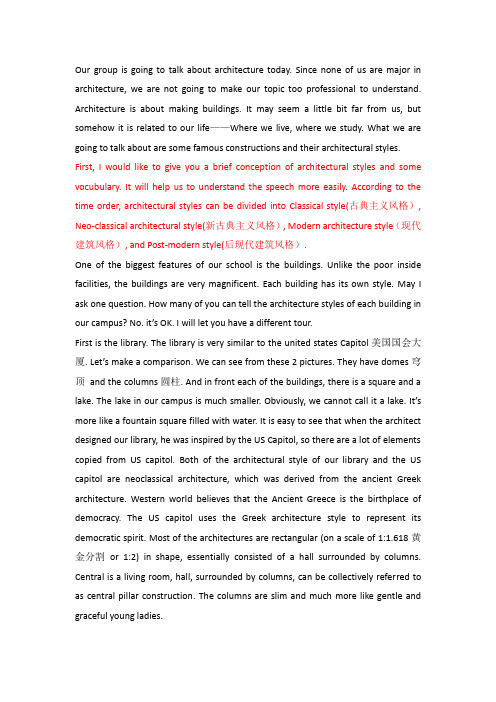
Our group is going to talk about architecture today. Since none of us are major in architecture, we are not going to make our topic too professional to understand. Architecture is about making buildings. It may seem a little bit far from us, but somehow it is related to our life——Where we live, where we study. What we are going to talk about are some famous constructions and their architectural styles. First, I would like to give you a brief conception of architectural styles and some vocubulary. It will help us to understand the speech more easily. According to the time order, architectural styles can be divided into Classical style(古典主义风格), Neo-classical architectural style(新古典主义风格), Modern architecture style(现代建筑风格), and Post-modern style(后现代建筑风格).One of the biggest features of our school is the buildings. Unlike the poor inside facilities, the buildings are very magnificent. Each building has its own style. May I ask one question. How many of you can tell the architecture styles of each building in our campus? No. it’s OK. I will let you have a different tour.First is the library. The library is very similar to the united states Capitol美国国会大厦. Let’s make a comparison. We can see from these 2 pictures. They have domes穹顶and the columns圆柱. And in front each of the buildings, there is a square and a lake. The lake in our campus is much smaller. Obviously, we cannot call it a lake. It’s more like a fountain square filled with water. It is easy to see that when the architect designed our library, he was inspired by the US Capitol, so there are a lot of elements copied from US capitol. Both of the architectural style of our library and the US capitol are neoclassical architecture, which was derived from the ancient Greek architecture. Western world believes that the Ancient Greece is the birthplace of democracy. The US capitol uses the Greek architecture style to represent its democratic spirit. Most of the architectures are rectangular (on a scale of 1:1.618黄金分割or 1:2) in shape, essentially consisted of a hall surrounded by columns. Central is a living room, hall, surrounded by columns, can be collectively referred to as central pillar construction. The columns are slim and much more like gentle and graceful young ladies.(一教楼)the college of journalism and communication is in this building. The biggest architecture characteristic of this building is its verandah外廊. This characteristic was used in India and Southeast Asia in 18th century. When British colonists designed buildings in these tropical countries, they brought British style but added some parts to adapt to the hot weather. The design of verandah helps to ventilate通风. The buildings in Guangzhou called 骑楼also use this design. The lecotropal arch马蹄形圆拱is a design mixed with Islamism and Christian. This architectural style is the result of western colonial rule.I want to introduce next 2 buildings together.二教楼and三教楼. It’s said that when these 2 buildings were being built, the workers took the wrong blueprint which made them share so many commons. They are European Architectural styles which are combined with ancient roman style.Ancient Roman architecture adopted certain aspects of Ancient Greek architecture, but it created lots of new architectural styles. Ancient Roman architecture is famous for its symmetrical construction对称性. Part of the building has the characteristics of feudal castle封建城堡.I cannot find out the style of the college of law四教楼. Its structure is like 2 weights on the scale天平上的2个砝码, which might represent the justice in law.五角楼the college of English literature is typical Victorian Architecture. It has red walls, many windows, and helm roofs尖顶with garden. Most Victorian houses had distinctive color schemes and exterior features, including mansard roofs, curves, arches, fancy brackets, columns, and unique and large windows.六教楼the college of Russian, as for me, it is the most luxurious building in our campus. Its doom is like a big golden onion. Typical Russian style, telling people we are rich so what!Beside the college of Russian is the college of eastern language. It’s rich too but its golden onion is smaller. Wait! They have 4 onions. The building is very similar to the Arabian style architecture. Its basic feature is the 4 corners of palm tree figure. The 4 little buildings are minarets宣礼塔. They are supposed to use as churches for Muslims. 伊斯兰教徒做礼拜. If we approach this building we can see some patterns on the wall, which are another feature of Arabian style architecture.The last building, the college of Japanese, is modern architecture style mixed with Japanese style. It is hiding behind a garden full of sakura trees. Every year in May, the trees blossom which makes the building more mysterious and peaceful.。
世界建筑演讲稿英文范文
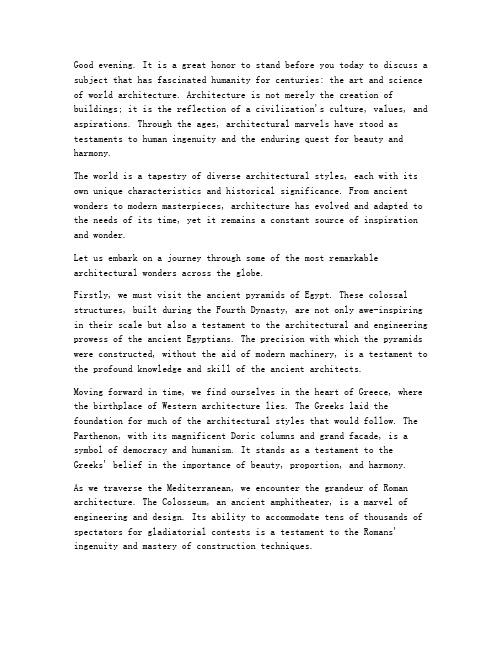
Good evening. It is a great honor to stand before you today to discuss a subject that has fascinated humanity for centuries: the art and science of world architecture. Architecture is not merely the creation of buildings; it is the reflection of a civilization's culture, values, and aspirations. Through the ages, architectural marvels have stood as testaments to human ingenuity and the enduring quest for beauty and harmony.The world is a tapestry of diverse architectural styles, each with its own unique characteristics and historical significance. From ancient wonders to modern masterpieces, architecture has evolved and adapted to the needs of its time, yet it remains a constant source of inspiration and wonder.Let us embark on a journey through some of the most remarkable architectural wonders across the globe.Firstly, we must visit the ancient pyramids of Egypt. These colossal structures, built during the Fourth Dynasty, are not only awe-inspiring in their scale but also a testament to the architectural and engineering prowess of the ancient Egyptians. The precision with which the pyramids were constructed, without the aid of modern machinery, is a testament to the profound knowledge and skill of the ancient architects.Moving forward in time, we find ourselves in the heart of Greece, where the birthplace of Western architecture lies. The Greeks laid the foundation for much of the architectural styles that would follow. The Parthenon, with its magnificent Doric columns and grand facade, is a symbol of democracy and humanism. It stands as a testament to the Greeks' belief in the importance of beauty, proportion, and harmony.As we traverse the Mediterranean, we encounter the grandeur of Roman architecture. The Colosseum, an ancient amphitheater, is a marvel of engineering and design. Its ability to accommodate tens of thousands of spectators for gladiatorial contests is a testament to the Romans' ingenuity and mastery of construction techniques.In Asia, we find the majesty of the Taj Mahal, an Islamic monument in Agra, India. This white marble mausoleum, built by Emperor Shah Jahan in memory of his wife, is renowned for its exquisite beauty and intricate craftsmanship. The Taj Mahal's symmetry, harmony, and intricate details have made it a symbol of love and architectural excellence.Jumping to the Americas, we discover the ancient ruins of Machu Picchuin Peru. This Incan city, nestled high in the Andes Mountains, is a testament to the architectural and agricultural prowess of the Inca civilization. The precise stone work and terracing techniques employed by the Incas are a marvel of ancient engineering.As we move into the modern era, we encounter the likes of Frank Lloyd Wright and Le Corbusier, whose innovative designs have left an indelible mark on the world. Wright's organic architecture, as seen in Fallingwater, blends the structure with its natural surroundings, creating a harmonious relationship between humanity and the environment. Corbusier's functionalist approach, exemplified by the Unitéd'Habitation, emphasized the importance of community and urban planning.In the 21st century, we continue to witness the evolution of architecture. Skyscrapers like the Burj Khalifa in Dubai and the Shanghai Tower demonstrate the heights to which modern technology and engineering have taken us. These structures push the boundaries of design and sustainability, offering a glimpse into the future of architecture.In conclusion, world architecture is a rich tapestry of cultural heritage, innovation, and aesthetic beauty. From the ancient pyramids to the modern skyscrapers, each structure tells a story of its time and place. As we continue to build for the future, let us remember the lessons of the past and strive to create spaces that are not only functional but also inspiring, beautiful, and sustainable.Thank you for joining me on this architectural journey. Let us appreciate the beauty and significance of world architecture and the timeless legacy it leaves behind.Thank you.。
著名建筑presentation
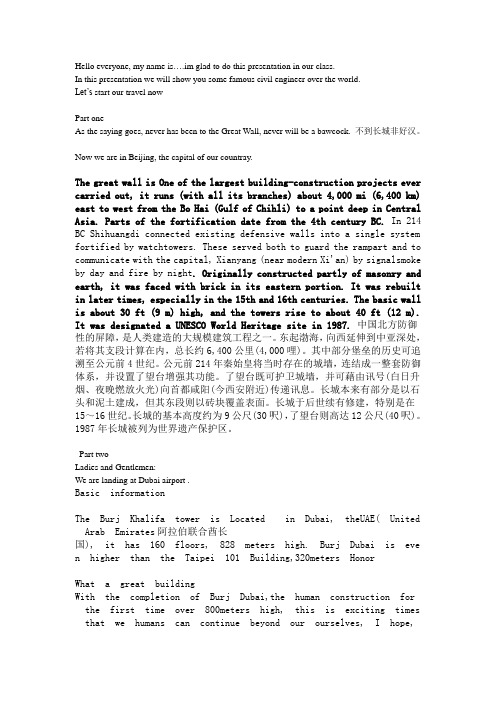
Hello everyone, my name is….im glad to do this presentation in our class.In this presentation we will show you some famous civil engineer over the world.Let’s start our travel nowPart oneAs the saying goes, never has been to the Great Wall, never will be a bawcock. 不到长城非好汉。
Now we are in Beijing, the capital of our countray.The great wall is One of the largest building-construction projects ever carried out, it runs (with all its branches) about 4,000 mi (6,400 km) east to west from the Bo Hai (Gulf of Chihli) to a point deep in Central Asia. Parts of the fortification date from the 4th century BC. In 214 BC Shihuangdi connected existing defensive walls into a single system fortified by watchtowers. These served both to guard the rampart and to communicate with the capital, Xianyang (near modern Xi'an) by signalsmoke by day and fire by night. Originally constructed partly of masonry and earth, it was faced with brick in its eastern portion. It was rebuilt in later times, especially in the 15th and 16th centuries. The basic wall is about 30 ft (9 m) high, and the towers rise to about 40 ft (12 m). It was designated a UNESCO World Heritage site in 1987.中国北方防御性的屏障,是人类建造的大规模建筑工程之一。
古建筑英语演讲稿三分钟
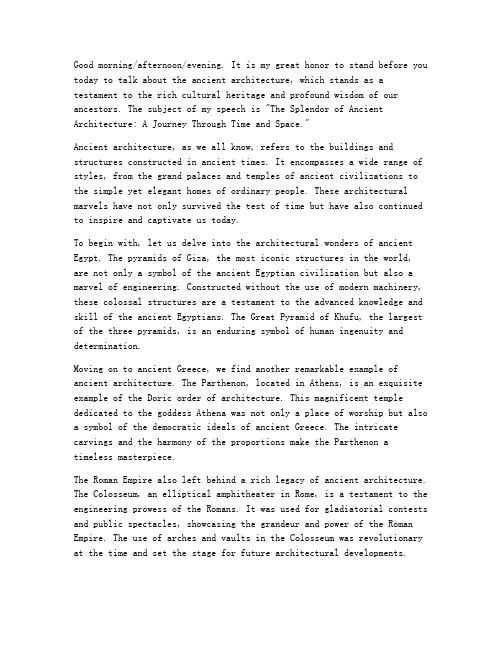
Good morning/afternoon/evening. It is my great honor to stand before you today to talk about the ancient architecture, which stands as a testament to the rich cultural heritage and profound wisdom of our ancestors. The subject of my speech is "The Splendor of Ancient Architecture: A Journey Through Time and Space."Ancient architecture, as we all know, refers to the buildings and structures constructed in ancient times. It encompasses a wide range of styles, from the grand palaces and temples of ancient civilizations to the simple yet elegant homes of ordinary people. These architectural marvels have not only survived the test of time but have also continued to inspire and captivate us today.To begin with, let us delve into the architectural wonders of ancient Egypt. The pyramids of Giza, the most iconic structures in the world, are not only a symbol of the ancient Egyptian civilization but also a marvel of engineering. Constructed without the use of modern machinery, these colossal structures are a testament to the advanced knowledge and skill of the ancient Egyptians. The Great Pyramid of Khufu, the largest of the three pyramids, is an enduring symbol of human ingenuity and determination.Moving on to ancient Greece, we find another remarkable example of ancient architecture. The Parthenon, located in Athens, is an exquisite example of the Doric order of architecture. This magnificent temple dedicated to the goddess Athena was not only a place of worship but also a symbol of the democratic ideals of ancient Greece. The intricate carvings and the harmony of the proportions make the Parthenon a timeless masterpiece.The Roman Empire also left behind a rich legacy of ancient architecture. The Colosseum, an elliptical amphitheater in Rome, is a testament to the engineering prowess of the Romans. It was used for gladiatorial contests and public spectacles, showcasing the grandeur and power of the Roman Empire. The use of arches and vaults in the Colosseum was revolutionary at the time and set the stage for future architectural developments.China, with its long history and diverse cultures, has produced some of the most breathtaking ancient architecture. The Forbidden City in Beijing, the imperial palace of the Ming and Qing dynasties, is a sprawling complex of palaces, gardens, and courtyards. It is a symbol of the majesty and power of the Chinese emperors. The intricate carvings, ornate roofs, and beautifully landscaped gardens all contribute to the grandeur of this ancient masterpiece.In Japan, ancient architecture reflects the harmony between humans and nature. The ancient temples and shrines, such as Kiyomizu-dera in Kyoto, are built with traditional wooden structures, showcasing the Japanese craftsmanship and respect for nature. The delicate balance between the architecture and the surrounding environment creates a serene and tranquil atmosphere.The architectural marvels of the Americas also deserve mention. The Machu Picchu in Peru, an Incan city built in the 15th century, is an extraordinary example of Incan engineering and architectural skill. The city is located at a high altitude and is surrounded by stunning natural landscapes, making it a true wonder of the world.Ancient architecture is not just a collection of buildings; it is a reflection of the values, beliefs, and aspirations of the people who built them. It tells a story of human progress, resilience, and creativity. As we admire these ancient structures, we are reminded of the incredible achievements of our ancestors and the timeless beauty of their creations.In conclusion, ancient architecture is a treasure trove of history and culture. It serves as a reminder of the rich heritage that we have inherited and the potential for innovation and creativity that lies within us. Let us cherish and preserve these architectural wonders for future generations to appreciate and learn from.Thank you for your attention, and I hope that my speech has ignited a spark of curiosity in all of you about the fascinating world of ancient architecture.[End of speech]。
建筑方案汇报英语

建筑方案汇报英语Architectural Proposal PresentationIntroduction:Good morning/afternoon, ladies and gentlemen. Today, I am delighted to have the opportunity to present to you our architectural proposal for the upcoming project. The aim of our proposal is to provide an innovative and functional design that not only meets the client's requirements but also contributes to the overall aesthetic appeal of the surrounding area.1. Client's Requirements:Firstly, let's discuss the client's requirements. Our client seeks a modern, sustainable, and technologically advanced building that will serve as a community center for both recreational and educational activities. The building should provide a harmonious blend of indoor and outdoor spaces, promoting a sense of connectedness with nature.2. Design Concept:To fulfill these requirements, we have developed a design concept centered around three key elements: functionality, sustainability, and aesthetics.2.1. Functionality:Efficient utilization of space is crucial to the success of any building. Our proposal includes a multifunctional layout that allows for flexible usage of the space. We have designated specific areas for recreational activities, classrooms, meeting rooms, and administrative offices. Each space has been carefully planned toensure ease of access and smooth circulation.2.2. Sustainability:Sustainability is at the core of our architectural philosophy. Our design incorporates various eco-friendly features, including passive cooling and heating systems, rainwater harvesting, and the use of renewable energy sources. We have also emphasized natural lighting and ventilation throughout the building to reduce energy consumption. Additionally, the integration of vertical gardens and green roofs enhances the overall environmental performance of the structure.2.3. Aesthetics:Aesthetics play a significant role in creating a visually appealing and harmonious environment. Inspired by the natural beauty of the surrounding landscape, our design features a sleek and modernfaçade, with large windows that provide stunning views and ample natural light. The exterior design is complemented by a combination of traditional and contemporary materials, ensuring a timeless appeal.3. Detailed Features:3.1. Recreational Areas:The community center boasts several recreational spaces, including a gymnasium, swimming pool, fitness center, and outdoor sports courts. These areas are designed to accommodate a variety of activities, catering to people of all ages and interests.3.2. Classrooms and Meeting Rooms:The educational aspect of the community center is equally important. We have incorporated well-equipped classrooms and meeting rooms that can be adapted for various purposes, such as workshops, seminars, and training sessions. These spaces are versatile and can be personalized to meet the specific needs of different user groups.3.3. Sustainable Features:As mentioned earlier, sustainability is a key element of our design. Our proposal includes solar photovoltaic panels on the roof, which will generate clean energy to power the building. We have also integrated rainwater collection and purification systems, reducing the dependency on external water sources. The choice of eco-friendly materials and the incorporation of green spaces further enhance the sustainability of the project.4. Conclusion:In conclusion, our architectural proposal provides a comprehensive solution that aligns with the client's requirements for a modern, sustainable, and visually appealing community center. Our design emphasizes functionality and flexibility, while also prioritizing environmental considerations. We believe that our proposal offers a unique opportunity to create a space that will enrich the lives of the community, foster learning, and promote a sustainable lifestyle. Thank you for your attention, and I welcome any questions or feedback you may have.。
建筑方案英文汇报

(19)
概念形成 Convept
原有建筑=展品 existing building=exhibit
新博物馆=展廊 New museum=pavement
(20)
概念形成 Convept
(21)
设计策略 Design Strategy
•屋顶花园供人漫步 Roof-garden •与老城呼应 Resposive to wateredge •强调形象创造 Emphasis on image making •当代本土语言 Contemporary vemacular language
Contents
先期调研 Previous Studies
案例研究 Precedent Studies
方案设计 Architectural Language
结语 Conclusion
老字号 Beijing Traditional Brand
商业老字号 文化老字号
Commerce Culture
老字号 Beijing Traditional Brand
今
present
建筑愿景 Archr
体验老字号
Experience
地理位置 Location
China,Beijing
Second Ring Road
Historical site
基地环境 environment
北面:琉璃厂古文化街
North: Liulichang Cultural Street
功能定位 Positioning
展览的据点 A Base for exhibition
休闲的目的地 A Destination for recreation
城市的地标 A Marking for city
英语建筑演讲稿范文
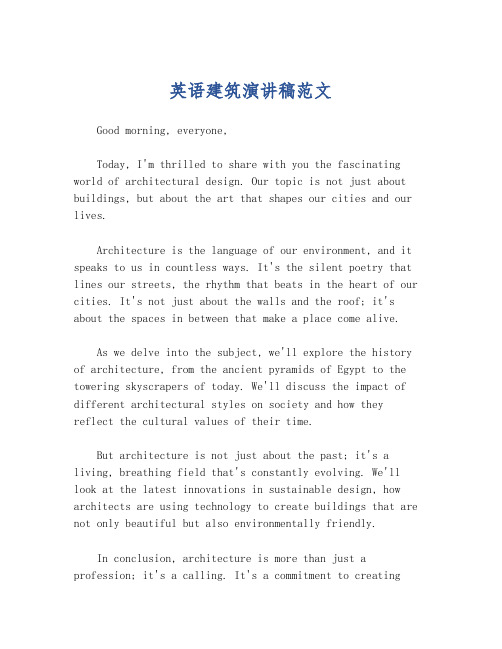
英语建筑演讲稿范文Good morning, everyone,Today, I'm thrilled to share with you the fascinating world of architectural design. Our topic is not just about buildings, but about the art that shapes our cities and our lives.Architecture is the language of our environment, and it speaks to us in countless ways. It's the silent poetry that lines our streets, the rhythm that beats in the heart of our cities. It's not just about the walls and the roof; it's about the spaces in between that make a place come alive.As we delve into the subject, we'll explore the history of architecture, from the ancient pyramids of Egypt to the towering skyscrapers of today. We'll discuss the impact of different architectural styles on society and how they reflect the cultural values of their time.But architecture is not just about the past; it's a living, breathing field that's constantly evolving. We'll look at the latest innovations in sustainable design, how architects are using technology to create buildings that are not only beautiful but also environmentally friendly.In conclusion, architecture is more than just a profession; it's a calling. It's a commitment to creatingspaces that inspire, that challenge, and that endure. As we continue to shape our world, let's remember that every brick, every beam, and every design choice has the power to change lives.Thank you for your attention, and I look forward to our journey into the world of architecture. Let's build a future that's as inspiring as the structures we admire.。
ARCHITECTURE PRESENTATION
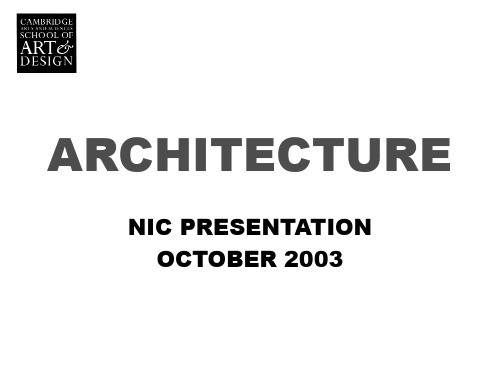
Student work 2003
Issues of architecture
• Function,Form,location • Materials,climate, orientation • Rhythm,space, structure • Surface,texture,light • Internal,external
MEDIEVAL
A.R.B.
• WORLD CLASS • MEMBER OF THE A.R.B. – THE ARCHITECTS REGISTRATION BOARD • CHARTERED MEMBER • INTERNATIONALLY RECOGNISED
CAMBRIDGE SCHOOL OF ART & DESIGN INNOVATION & TRADITION
SHAPING THE FUTURE
• DEFINE WAYS OF LIVING • INNOVATE THE EXISTING • CREATE THE NEW
AT THE FOREFRONT OF DESIGN
attributes
• A SENSE OF PURPOSE • PEOPLE AND ENVIROMENT • MAKE A POSITIVE MARK
whycsad
• 9professionaltutors • smallindividuallydirected groups • linkswithtopArchitecture Schools, UK&US • historicCambridge
foundationterm1
rotation+core
foundationterm2
介绍建筑展英语作文
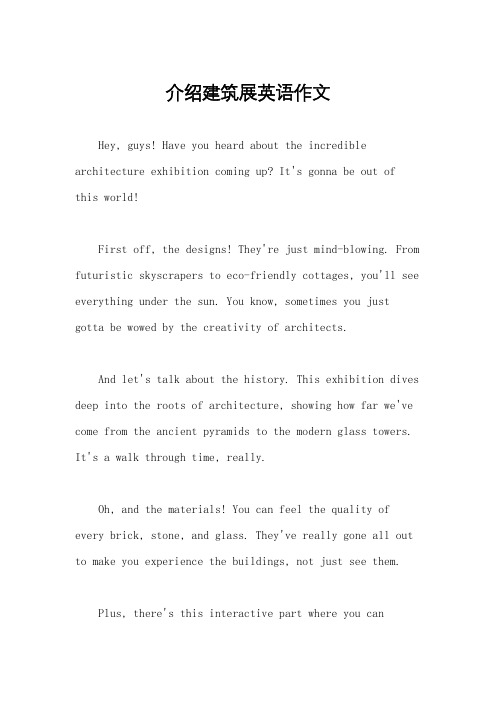
介绍建筑展英语作文Hey, guys! Have you heard about the incredible architecture exhibition coming up? It's gonna be out ofthis world!First off, the designs! They're just mind-blowing. From futuristic skyscrapers to eco-friendly cottages, you'll see everything under the sun. You know, sometimes you just gotta be wowed by the creativity of architects.And let's talk about the history. This exhibition dives deep into the roots of architecture, showing how far we've come from the ancient pyramids to the modern glass towers. It's a walk through time, really.Oh, and the materials! You can feel the quality of every brick, stone, and glass. They've really gone all out to make you experience the buildings, not just see them.Plus, there's this interactive part where you canvirtually build your own house! Yeah, you heard me. Step into the VR world and design your dream home. It's super cool!And last but not least, the atmosphere! It's like stepping into a whole new universe. The lighting, the sounds, everything is perfectly crafted to make you feel like you're actually in those buildings.So, what are you waiting for? Grab your tickets and head over to the exhibition. It's gonna be an amazing experience, I promise!。
建筑英语演讲稿范文
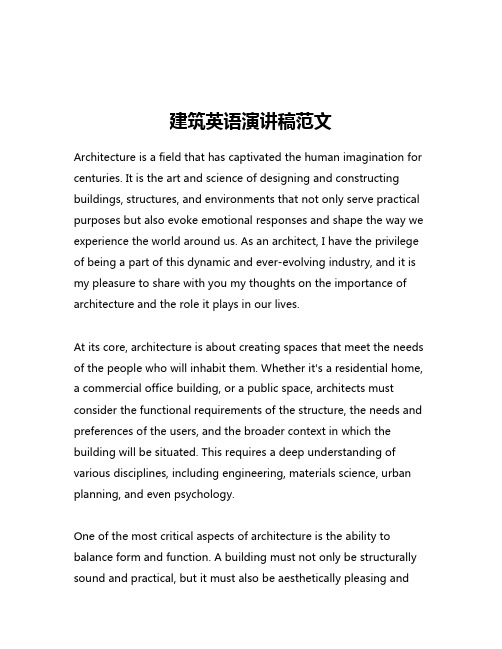
建筑英语演讲稿范文Architecture is a field that has captivated the human imagination for centuries. It is the art and science of designing and constructing buildings, structures, and environments that not only serve practical purposes but also evoke emotional responses and shape the way we experience the world around us. As an architect, I have the privilege of being a part of this dynamic and ever-evolving industry, and it is my pleasure to share with you my thoughts on the importance of architecture and the role it plays in our lives.At its core, architecture is about creating spaces that meet the needs of the people who will inhabit them. Whether it's a residential home, a commercial office building, or a public space, architects must consider the functional requirements of the structure, the needs and preferences of the users, and the broader context in which the building will be situated. This requires a deep understanding of various disciplines, including engineering, materials science, urban planning, and even psychology.One of the most critical aspects of architecture is the ability to balance form and function. A building must not only be structurally sound and practical, but it must also be aesthetically pleasing andevoke a certain emotional response. This is where the art of architecture comes into play. Architects must possess a keen eye for design, an understanding of color, texture, and proportion, and the ability to translate their vision into a tangible reality.As an architect, I am particularly fascinated by the way in which buildings can shape the human experience. The design of a space can have a profound impact on the way we move through it, the way we interact with others, and the way we feel. For example, a well-designed office space can foster collaboration and creativity, while a carefully planned public square can encourage community engagement and social interaction.Moreover, architecture has the power to reflect and shape the cultural identity of a place. The iconic buildings and structures that define a city or a region often serve as symbols of the local history, values, and traditions. From the towering skyscrapers of New York City to the intricate temples of Kyoto, each architectural masterpiece tells a unique story about the people and the culture that created it.However, the role of architecture extends far beyond the aesthetic and cultural realms. It also has significant implications for the environment and sustainability. As the world grapples with the challenges of climate change and resource scarcity, architects are at the forefront of developing innovative solutions that prioritizeenergy efficiency, renewable energy, and the responsible use of materials. By designing buildings that minimize their environmental impact, architects can play a crucial role in shaping a more sustainable future.In conclusion, architecture is a multifaceted and dynamic field that touches every aspect of our lives. From the practical to the emotional, from the cultural to the environmental, architects have the power to shape the world around us in profound and meaningful ways. As an architect, I am deeply passionate about this profession and the countless possibilities it holds for improving the human experience and creating a better future for all.。
architecture课堂presentation
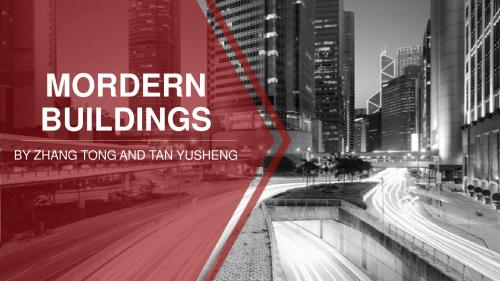
LOREM IPSUM DOLOR SIT AMET
ON MODERN ARCHITECTUREHale Waihona Puke MOREFOCUS
RECYCLEBLE M
ATTRACTIVE AP
ON FUNCTIONS
ARTERIALS
PREANCE
谢 谢 大 家!
MORDERN BUILDINGS
BY ZHANG TONG AND TAN YUSHENG
LOREM IPSUM DOLOR SIT AMET
State of Tax office building
JPMorgan Chase & Co. is an American multinational banking and financial services holding company headquartered in New York City. It is the largest bank in the United States, and the world's sixth largest bank by total assets, with total assets of US$2.6 trillion. It is a major provider of financial services, and according to Forbes magazine is the world's third largest public company based on a composite ranking.
JIN MAO TOWER Pudong New District 3th in shanghai 88 floors near to SWFC
英文演讲稿-关于建筑
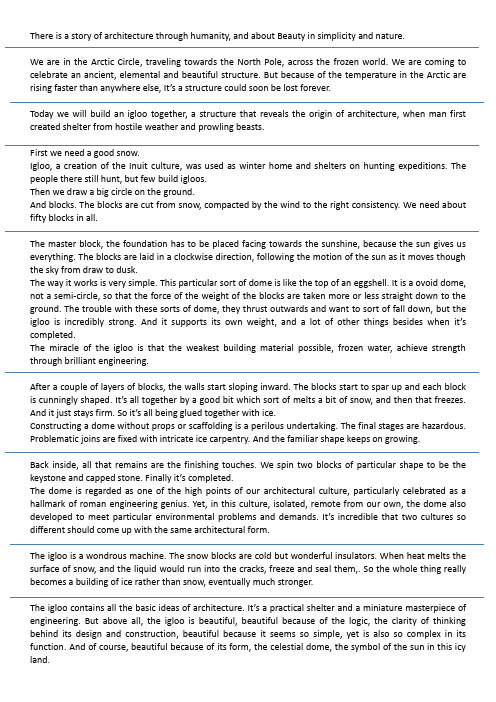
There is a story of architecture through humanity, and about Beauty in simplicity and nature.We are in the Arctic Circle, traveling towards the North Pole, across the frozen world. We are coming to celebrate an ancient, elemental and beautiful structure. But because of the temperature in the Arctic are rising faster than anywhere else, It’s a structure could soon be lost forever.Today we will build an igloo together, a structure that reveals the origin of architecture, when man first created shelter from hostile weather and prowling beasts.First we need a good snow.Igloo, a creation of the Inuit culture, was used as winter home and shelters on hunting expeditions. The people there still hunt, but few build igloos.Then we draw a big circle on the ground.And blocks. The blocks are cut from snow, compacted by the wind to the right consistency. We need about fifty blocks in all.The master block, the foundation has to be placed facing towards the sunshine, because the sun gives us everything. The blocks are laid in a clockwise direction, following the motion of the sun as it moves though the sky from draw to dusk.The way it works is very simple. This particular sort of dome is like the top of an eggshell. It is a ovoid dome, not a semi-circle, so that the force of the weight of the blocks are taken more or less straight down to the ground. The trouble with these sorts of dome, they thrust outwards and want to sort of fall down, but the igloo is incredibly strong. And it supports its own weight, and a lot of other things besides when it’s completed.The miracle of the igloo is that the weakest building material possible, frozen water, achieve strength through brilliant engineering.After a couple of layers of blocks, the walls start sloping inward. The blocks start to spar up and each block is cunningly shaped. It’s all together by a good bit which sort of melts a bit of snow, and then that freezes. And it just stays firm. So it’s all being glued together with ice.Constructing a dome without props or scaffolding is a perilous undertaking. The final stages are hazardous. Problematic joins are fixed with intricate ice carpentry. And the familiar shape keeps on growing.Back inside, all that remains are the finishing touches. We spin two blocks of particular shape to be the keystone and capped stone. Finally it’s completed.The dome is regarded as one of the high points of our architectural culture, particularly celebrated as a hallmark of roman engineering genius. Yet, in this culture, isolated, remote from our own, the dome also developed to meet particular environmental problems and demands. It’s incredible that two cultures so different should come up with the same architectural form.The igloo is a wondrous machine. The snow blocks are cold but wonderful insulators. When heat melts the surface of snow, and the liquid would run into the cracks, freeze and seal them,. So the whole thing really becomes a building of ice rather than snow, eventually much stronger.The igloo contains all the basic ideas of architecture. It’s a practical shelter and a miniature masterpiece of engineering. But above all, the igloo is beautiful, beautiful because of the logic, the clarity of thinking behind its design and construction, beautiful because it seems so simple, yet is also so complex in its function. And of course, beautiful because of its form, the celestial dome, the symbol of the sun in this icy land.。
建筑方案英语汇报

建筑方案英语汇报Building design presentationIntroduction:Good morning/afternoon/evening everyone,I hope you are all doing well. Today, I am here to present the building design proposal for [project name]. This presentation will provide an overview of the design concept, architectural plans, and key features of the proposed building. I invite you all to take a closer look at the visual presentations and feel free to ask any questions at the end. Let's get started!Design Concept:The design concept for [project name] is inspired by [insert inspiration]. Our aim was to create a building that harmonizes with the surrounding environment while also incorporating modern and sustainable design elements.Architectural Plans:1. Exterior:The building's exterior will feature a combination of glass, steel, and concrete to create a contemporary and sleek look. The façade will be designed with large windows to allow natural light into the building, reducing the need for artificial lighting during the day.2. Interior:The interior design focuses on creating a functional and aesthetically pleasing space. The layout ensures efficient circulation and maximizes the use of natural light. We haveincorporated open spaces, communal areas, and green elements such as indoor plants to create a healthy and collaborative environment for the occupants.Key Features:1. Green Initiatives:The building will incorporate various sustainable features to reduce its environmental impact. These include rainwater harvesting systems, solar panels for electricity generation, and energy-efficient HVAC systems. We also plan to incorporate green spaces on the roof and vertical gardens around the building, promoting biodiversity and providing a visually appealing environment.2. Smart Technology:To enhance the occupants' comfort and convenience, the building will be equipped with state-of-the-art smart technology. This includes automated lighting, temperature control, and smart security systems. This technology will not only improve the overall efficiency of the building but also increase security and user satisfaction.3. Flexibility:The design of the building takes into consideration the changing needs and requirements of the occupants. The floor plans allow for flexible space allocation, making it easy to adapt to different functions and layouts over time. This feature ensures future-proofing and longevity of the building.4. Accessibility:Ensuring accessibility for all is an integral part of the buildingdesign. There will be ramps, elevators, and accessible public spaces to cater to individuals with disabilities. In addition, the building will meet all relevant standards and regulations regarding accessibility.Conclusion:In conclusion, the proposed building design for [project name] combines modern architecture, sustainable features, and innovative technology to create a functional and aesthetically pleasing space. The emphasis on green initiatives, smart technology, flexibility, and accessibility ensures that the building meets the needs of both the occupants and the environment. Thank you for your attention. I am now open to any questions or feedback you may have.。
建筑 Architecture Presentation

21. The farm
摩天农场
22. The floating city
• It is the building into a completely self-sufficient city, can drift in the oceans, natural disaster and rescue is lead to sea levels rising high makes people displaced solutions. By combining heat energy, tidal power(潮汐能), solar and wind energy and so on many kinds of technology to make energy. And capacity is very big, can hold about 50000 people normal life. The three dimensional building design also created the hill and valley, and the leisure, business and commerce, and residential areas, so as to create an organic complex body, just like people spend a lifetime of good places.
17. Sustainable skyscrapers
可持续摩天大楼
• The sustainable development of the skyscrapers not only like photos on the surface of the same is green, and also has a large photoelectric board, natural ventilation equipment, and biogas generated factory. This design is one of the most special of place it through the external corridor invite public experience building greenhouse, and at the same time, these passages or leads to the building of one side of the hotel and other public unit.
- 1、下载文档前请自行甄别文档内容的完整性,平台不提供额外的编辑、内容补充、找答案等附加服务。
- 2、"仅部分预览"的文档,不可在线预览部分如存在完整性等问题,可反馈申请退款(可完整预览的文档不适用该条件!)。
- 3、如文档侵犯您的权益,请联系客服反馈,我们会尽快为您处理(人工客服工作时间:9:00-18:30)。
路漫漫其修远兮, 吾将上下而求索
5. The Las Vegas city heart with green
拉斯维加斯市心脏披上“绿衣”
路漫漫其修远兮, 吾将上下而求索
6. The world's most "green" buildings
世界上最“绿色”的建筑
• This is in the world the most "green" building itself can generate electricity. It is the first of the roof of the installation, it is the solar panels, in the rest part hasn't completed before, the "monster" has been in power generation road great strides. Project completion, the entire building will be the power consumption of the lowest in the world of all construction.
路漫漫其修远兮, 吾将上下而求索
14. Don't block the light skyscrapers
不挡光的摩天大楼
路漫漫其修远兮, 吾将上下而求索
15. Green and high-tech of perfect combination of villa
路漫漫其修远兮, 吾将上下而求索
protect both residents
建筑 ArchitecturePresentati
on
路漫漫其修远兮, 吾将上下而求索
2020年4月13日星期一
Architecture
• Green Building(绿色建筑) • Modern Black Homes
路漫漫其修远兮, 吾将上下而求索
Green Building
• Meaning: • Green Building is to point to the practice to
19. The great pretender building
善于伪装的大楼
路漫漫其修远兮, 吾将上下而求索
20. Kill two birds with one stone
building
一举两得的大楼
• This is a grand and beautiful building and unique building appearance and the necessary environment with the strategy of another example. Curved surface not only produces aesthetic feeling on the vision, and there's a certain function, make full use of the direction of the wind and the sun, to
路漫漫其修远兮, 吾将上下而求索
2. Self-sufficient star city 自给自足的星城
路漫漫其修远兮, 吾将上下而求索
3. The sustainable communities 可持续社区
路漫漫其修远兮, 吾将上下而求索
4. the growth of organic house
improve building use resourses (energy、water and materials ) efficiency. And, at the same time, reduce building to the human body health and enviroment effects from better location, design, construction, operation, maintenance (/'meintənəns/维修) and dismantlement(拆除) for the whole complete the building life cycle.
路漫漫其修远兮, 吾将上下而求索
荷兰delft大学图书馆
• 22 Global Green Building
路漫漫其修远兮, 吾将上下而求索
1. Folding an emergency shelter 可折叠的紧急避难所
• This kind of an emergency shelter can adapt to different environment, can provide a variety of refuge([‘refju:dʒ] ) in space at the same time. Now that is can be folded, the emergency shelter nature is very easy to transport and install, in addition, due to the use of organic material, people can also the reuse. With sustainability(持续性) and practical this two advantages, this can be folded building can have a wide variety of USES(美国就业局), not limited to act as an emergency shelter.
便携式活动体育场
• The current most tour organizers are required for the corresponding field, these sites often is fixed, such as the gym, theatres and so on. I‘m afraid old circus and only performance is still a group of “the backpackers”, namely select(挑选/si'lekt/) the way can set up shop. This picture proposed stadium or performance space structure USES the current popular portable design. It can be remove in any one place. Also, it can be a kind of futuristic colour mobile with products. Portable stadium is part of the super light structure design, other part can inflate. All building materials can be stored in 30 container which is easy to transport and maximize the improve its flexibility. In addition, the stadium can also be quickly install and remove, before and after about a week or two weeks only needs time.
路漫漫其修远兮, 吾将上下而求索
• famous green building in the world
路漫漫其修远兮, 吾将上下而求索
Britain's BRE green environment floor
路漫漫其修远兮, 吾将上下而求索
英国的BRE绿色环境楼
British Integer of the green house paradigmatic room
路漫漫其修远兮, 吾将上下而求索
11. The appearance of sleek sustainable
racing center
外观圆滑的可持续赛车中心
路漫漫其修远兮, 吾将上下而求索
[sai'biəriən]
12. The Siberian multi-function super minarets
路漫漫其修远兮, 吾将上下而求索
英国整体绿色住宅示范房
Japan’s solar houses
路漫漫其修远兮, 吾将上下而求索
日本太阳能住宅
Japan’s multilayer solar houses
路漫漫其修远兮, 吾将上下而求索
日本多层太阳能住宅
The Dutch Delft University Library
路漫漫其修远兮, 吾将上下而求索
9. The future yurt pie 未来派蒙古包
路漫漫其修远兮, 吾将上下而求索
10. Portable activities stadium
便携式活动体育场
路漫漫其修远兮, 吾将上下而求索
10. Portable activities stadium
16. Green and high-tech of perfect combination of villa
路漫漫其修远兮, 吾将上下而求索
17. Sustainable skyscrapers
可持续摩天大楼
• The sustainable development of the skyscrapers not only like photos on the surface of the same is green, and also has a large photoelectric board, natural ventilation equipment, and biogas generated factory. This design is one of the most special of place it through the external corridor invite public experience building greenhouse, and at
